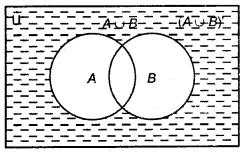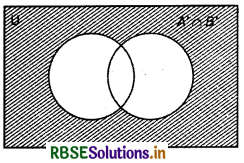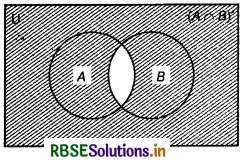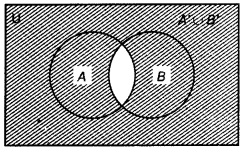RBSE Solutions for Class 11 Maths Chapter 1 Sets Ex 1.5
Rajasthan Board RBSE Solutions for Class 11 Maths Chapter 1 Sets Ex 1.5 Textbook Exercise Questions and Answers.
Rajasthan Board RBSE Solutions for Class 11 Maths in Hindi Medium & English Medium are part of RBSE Solutions for Class 11. Students can also read RBSE Class 11 Maths Important Questions for exam preparation. Students can also go through RBSE Class 11 Maths Notes to understand and remember the concepts easily.
RBSE Class 11 Maths Solutions Chapter 1 Sets Ex 1.5
Question 1.
Let U = {1, 2, 3, 4, 5, 6, 7, 8, 9}, A ={1, 2, 3, 4}, B = {2, 4, 6, 8} and C = {3, 4, 5, 6}, find :
(i) A'
(ii) B'
(ii) (A ∪ C)
(iv) (A ∪ B)'
(v) (A')'
(vi) (B - C)
Answer:
(i) A' = U - A = {5, 6, 7, 8, 9}
(ii) B' = U - B
= {1, 3, 5, 7, -9}
(iii) A ∪ C = {1, 2, 3, 4, 5, 6}
⇒ (A ∪ C) = U - (A ∪ C)
= {7, 8, 9}
(iv) (A ∪ B) = {l, 2,3, 4, 6,8}
(A ∪ B)' = U - (A ∪ B).
= {5, 7, 9}
(v) A'= U - A = {5, 6,7,8, 9}
∴ (A')' = U - A' = {1, 2, 3, 4} = A
(vi) B - C = {x,:x ∈ B but x ∉ C} = {2,8}
Thus (B - C)' = U - (B - C)
= {1, 2,3, 4,5, 6,7,8, 9} - {2,8}
= {1, 3, 4, 5, 6, 7, 9}

Question 2.
If U = {a, b, c, d, e, f, g, h}, find the complements of the following sets :
(i) A = {a,b,c}
(ii) B = {d,e,f,g)
(iii) C = {a, c,e,g}
(iv) D = {f,g, h, a}
Answer:
(i) A = {a, b, c} then
A' = U - A = {d, e,f g, h}
(ii) B = {d, e,f g} then B' = U - B = {a, b, c, h}
(iii) C = {a, c, e, g} then C' = U- C = {b, d,f, h)
(iv) D = {f, g, h, a] then
D' = U - D = {b, c, d, e}
Question 3.
Taking the set of natural numbers as the universal set, write down the complements of the following sets:
(i) {x: x is an even natural number}
(ii) {x :x is an odd natural number}
(iii) (x: x is a positive multiple of 3}
(iv) {x: x is a prime number}
(v) {x: x is a natural number divisible by 3 and 5}
(vi) {x: x is a perfect square} .
(vii) {x: x is a perfect cube}
(viii) (x: x + 5 = 8}
(ix) {x: 2x + 5 = 9}
(x) {x: x > 7}
(xi) {x: x ∈ N and 2x +1 > 10}
Answer:
Given:
U = {x :x all are natural numbers}
i. e., U = {1, 2, 3, 4, 5, 6, 7, 8, 9, 10,....}
(i) Let A = {x :x is an even natural number}
So, A' = U - A = {x: x is a odd natural naumber}
= {1, 3, 5, 7, 9, 11, 13, ........}
(ii) Let B = {x : x is a odd natural number}
B' = U - B = {x : x ∈ U but x € B}
= {2, 4, 6, 8, 10, .............}
= {x: x is an even natural number}
(iii) U = set of natural numbers
N = (1, 2, 3, 4, 5, 6, 7, 8, 9, 10,................}
C = {x : x is a cubic multiple of number 3}
C = {3, 6, 9, 12, 15,..............}
{x: x is positive multiple of number 3}
C'= (1,2,4, 5, 7, 8, 10, 11 }
C'= {x: x ∈ N; and A is not multiple of 3}
(iv) A = {A : x is a prime number}'
∴ A' = U - A .
Thus, A' = {1,4, 6,8, 9,10,12,14.15,16....}
A'= {A: A is not a prime number
(v) U= {1, 2, 3, 4, 5, 6, 7, 8,9......... }
A' = {A : A is a natural number divisible by 3 and 5}
A' = U - A = {A:A is a positive integer which is neither divisible by 3 nor by 5}
(vi) U= {A :A is a natural number}
X = {A:A is a perfect square} 1 X' = U - X = {A : A is not a perfect square}
(vii) U = {A : A is a natural numbers}
Y = : A is a perfect cube}
Y' = {A : A is not a perfect cube}
(viii) {x :x ∈ N and x ≠ 3}
Since, x + 5 = 8 on solving x = 3,
Thus, except 3, set will contain all natural numbers.
(ix) (r: 2x + 5 = 9} solving 2x + 5 = 9 and 2x + 5 = 9 or 2x = 4 or x = 2
Thus, except 2, set will contain all natural numbers.
⇒ {x:x ∈ N; x ≠ 2}
(x) In set {x: x > 7}, x = 7 or x > 7 and all numbers are elements so its complement set will be x < 7 and will be written as {x : x ∈ N; x < 7} (xi) {x :x ∈ N and 2x + 1 >10}.
Here, 2x +1 > 10 from 2x > 9 or x > 9/2
Thus, given set{r :A ∈ N and x > 9/2}

Question 4.
If U = {1, 2, 3, 4, 5, 6, 7, 8, 9}, A = {2, 4, 6, 8} and B = {2, 3, 5, 7}, verify that:
(i) (A ∪ B)' = A' ∩ B'
(ii)(A ∩ B)' = A' u B'
Solution:
(i) A ∪ B = [2,3,4,5,6,7,8}
A' = U - A = {1,3,5,7, 9}
B' = U - B = {1,4,6,8,9}
∴ (A ∪ B)' = {1, 9), A' ∩ B' = {1, 9)
Thus, (A ∪ B)' = A'' ∩ B'
Hence Proved
(ii) A ∩ B={2)
A' ∪ B' = {1, 3, 4, 5, 6, 7, 8, 9} and (A ∩ B)'=( 1, 3, 4, 5, 6, 7, 8, 9}
Thus, (A ∩ B)' = A' ∪ B'
Hence Proved
Question 5.
Draw appropriate venn diagram for each of the following:
(i) (A ∪ B)'
(ii) A' ∩ B'
(iii) (A ∩ B)'
(iv) A' ∪ B '
Answer:
(i) Shaded part represents (A ∪ B)'.

(ii) A' ∩ B'= (U - A) ∩ (U - B)
Thus, A' ∩ B' = U is set of elements which are neither in A neither in B.

Shaded part represents A' ∩ B'.
(iii) (A ∩ B)' = U - (A ∩ B)

Thus, set of elements which are neither in A and nor in B is (A ∩ B). Shaded part represents (A ∩ B)'.
(iv) A' = U - A and B' = U - B

Thus, A' ∪ B' = (U - A) ∪ (U - B) is set of elements which are not in A or B. Shaded part represents A' ∪ B'.

Question 6.
Let U be the set of all triangles in a plane. If A is the set of all triangles with at least one angle different from 60°. What is A'?
Answer:
Given : Universal set U = set of all triangles in plane.
and A = set of all the traingles in which one angle is other than 60°.
i. e., in set A, no equilateral triangle exist since each angle of equilateral triangle is 60°.
Thus, complement set of set A i.e., A' - U - A
⇒ A' = {x: x ∈ U but x ∉ A} set of equilateral trialngles
Thus, A' = {x : x is an equilateral triangle} or A' = set of all equilateral triangles.
Question 7.
Fill in the blanks to make each of the following a true statement:
(i) A ∪ A' =
(ii) Φ' ∩ A =
(iii) A ∩ A' =
(iv) U' ∩ A=
Answer:
(i) A ∪ A' = U (universal set)
(ii) Φ' ∩ A = U ∩ A
= A (∵ Φ = U universal set)
(iii) A ∩ A' = Φ,
Since A and A' has no common element.
(iv) U' ∩ A = Φ ∩ A = Φ (∵ U'=$)
U' = U - U = Φ = Null set

- RBSE Solutions for Class 11 Maths Chapter 3 त्रिकोणमितीय फलन Ex 3.1
- RBSE Solutions for Class 11 Maths Chapter 2 संबंध एवं फलन विविध प्रश्नावली
- RBSE Solutions for Class 11 Maths Chapter 2 संबंध एवं फलन Ex 2.3
- RBSE Solutions for Class 11 Maths Chapter 2 संबंध एवं फलन Ex 2.2
- RBSE Solutions for Class 11 Maths Chapter 2 संबंध एवं फलन Ex 2.1
- RBSE Solutions for Class 11 Maths Chapter 1 समुच्चय विविध प्रश्नावली
- RBSE Solutions for Class 11 Maths Chapter 1 समुच्चय Ex 1.6
- RBSE Solutions for Class 11 Maths Chapter 1 समुच्चय Ex 1.5
- RBSE Solutions for Class 11 Maths Chapter 1 समुच्चय Ex 1.4
- RBSE Solutions for Class 11 Maths Chapter 1 समुच्चय Ex 1.3
- RBSE Solutions for Class 11 Maths Chapter 1 समुच्चय Ex 1.2